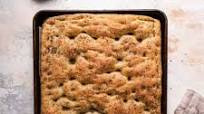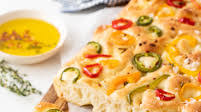What should I make for dinner tonight? This might just be the number one question that we ask ourselves almost daily over here.
Then you have come to the right place, we have rounded up 15 best flour for focaccia that we have shared over the years.
Plus, there is such a variety of flavours in these recipes, so you are sure to find something for you. Most of these recipes are quick and easy ones made especially for busy weeknights.
15 Best Flour For Focaccia
The Best, Easiest Focaccia Bread Recipe
Easy Rosemary Garlic Focaccia Bread
Homemade Focaccia Bread Recipe
Garlic Rosemary Herb Focaccia
No-Fuss Focaccia
Rosemary Focaccia Bread
Focaccia Bread Recipe
Focaccia recipe
Italian Focaccia Bread Recipe
Ridiculously Easy Focaccia Bread
Easy Focaccia Recipe
Better Baking Academy: Summer Focaccia
Is bread flour or all purpose flour better for focaccia?
Bread Flour – Using bread flour gives the focaccia a chewy texture; you can substitute all-purpose flour without ruining the recipe, but your bread will be significantly lighter and missing that characteristic texture.
What are two tips to making a good focaccia bread?
Brining and salting your focaccia for the best flavor. To make plain focaccia, add salt, water, and oil to create a salty brine and brush liberally over the dough before baking. Another option is to brush with extra virgin olive oil and Maldon sea salt. After baking brush one more time with more extra virgin olive oil.
Why is my focaccia not fluffy?
Make sure the yeast is bubbling and foamy before you add it to the dry ingredients. If it doesn’t foam after a few minutes, pour it out and start with fresh yeast. It may seem like a lot of olive oil in the pan and poured over the dough, but never fear!
How does Gordon Ramsay make focaccia?
What makes a good focaccia?
Use a sourdough starter or other means of natural leavening to give focaccia dough its rise. A long rise with natural leavening is the best way to make focaccia, as this method creates subtle new flavors and deeper complexity. But if you don’t use natural leavening, don’t worry.
Why is my focaccia so dense?
Not enough water: This can leave you with dense, dry focaccia. For accuracy, measure out your ingredients using weight instead of cups to ensure you have the right ratio of ingredients. 2. Not proved enough: Depending on the temperature, focaccia dough can take anywhere between 1-3 hours to proof.
Should focaccia be thick or thin?
As a general rule of thumb, a classic Italian-style pizza crust will be less than half an inch thick while most focaccia will be at least three-quarters of an inch thick. Also, focaccia is most commonly served at room temperature — though you can also eat focaccia bread cold or toasted.
Can you Overproof focaccia dough?
Can you overproof focaccia? Yes, if you let the dough proof too long then the gluten structure will get weak and the bread will collapse when you bake it.
Why is focaccia dimpled right before baking?
the dimples
The traditional dimples you see on focaccia are there for a reason. They reduce the air in the dough and prevent the bread from rising too quickly. After proper kneading and proving there will be plenty of large bubbles in the dough.
Can you over knead focaccia?
Over-kneaded dough will also tear easily; in under-kneaded dough this is because the gluten hasn’t become elastic enough, but in over-kneaded dough, this means that the gluten is so tight that it has very little give. If you think you’ve over-kneaded the dough, try letting it rise a little longer before shaping it.
How wet should focaccia dough be?
This dough will be very, very wet – almost like cake mix. If you can, wet your hands (to stop them sticking) and fold the dough over a little, just to see what a dough of this wetness (or ‘hydration’) feels like.
Is homemade focaccia healthy?
Benefits for your figure and your health
Rather, focaccia provides complex carbohydrates that slowly give the body energy and help better regulate blood sugar levels,” Schirò explains. If it’s made with whole wheat flour then it’s got an extra edge. “It provides a greater amount of vitamins, minerals and fiber.














